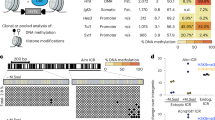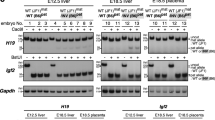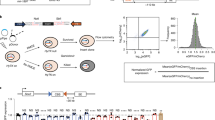Abstract
The Insulin-like growth factor 2 (Igf2) and H19 genes are imprinted, resulting in silencing of the maternal and paternal alleles, respectively. This event is dependent upon an imprinted-control region two kilobases upstream of H19 (refs 1, 2). On the paternal chromosome this element is methylated and required for the silencing of H19 (refs 2,3,4). On the maternal chromosome the region is unmethylated and required for silencing of the Igf2 gene 90 kilobases upstream2. We have proposed that the unmethylated imprinted-control region acts as a chromatin boundary that blocks the interaction of Igf2 with enhancers that lie 3′ of H19 (refs 5, 6). This enhancer-blocking activity would then be lost when the region was methylated, thereby allowing expression of Igf2 paternally. Here we show, using transgenic mice and tissue culture, that the unmethylated imprinted-control regions from mouse and human H19 exhibit enhancer-blocking activity. Furthermore, we show that CTCF, a zinc finger protein implicated in vertebrate boundary function7, binds to several sites in the unmethylated imprinted-control region that are essential for enhancer blocking. Consistent with our model, CTCF binding is abolished by DNA methylation. This is the first example, to our knowledge, of a regulated chromatin boundary in vertebrates.
This is a preview of subscription content, access via your institution
Access options
Subscribe to this journal
Receive 51 print issues and online access
$199.00 per year
only $3.90 per issue
Buy this article
- Purchase on Springer Link
- Instant access to full article PDF
Prices may be subject to local taxes which are calculated during checkout




Similar content being viewed by others
References
Leighton, P. A., Ingram, R. S., Eggenschwiler, J., Efstratiadis, A. & Tilghman, S. M. Disruption of imprinting caused by deletion of the H19 gene region in mice. Nature 375, 34–39 (1995).
Thorvaldson, J. L., Duran, K. L. & Bartolomei, M. S. Deletion of the H19 differentially methylated domain results in loss of imprinted expression of H10 and Igf2. Genes Dev. 12, 3693–3702 (1998).
Bartolomei, M. S., Webber, A. L., Brunkow, M. E. & Tilghman, S. M. Epigenetic mechanisms underlying the imprinting of the mouse H19 gene. Genes Dev. 7, 1663–1673 (1993).
Ferguson-Smith, A. C., Sasaki, H., Cattanach, B. M. & Surani, M. A. Parental-origin-specific epigenetic modifications of the mouse H19 gene. Nature 362, 751–755 (1993).
Webber, A., Ingram, R. I., Levorse, J. & Tilghman, S. M. Location of enhancers is essential for imprinting of H19 and Igf2 . Nature 391, 711–715 (1998).
Hark, A. T. & Tilghman, S. M. Chromatin conformation of the H19 epigenetic mark. Hum. Mol. Genet. 7, 1979–1985 (1998).
Bell, A. C., West, A. G. & Felsenfeld, G. The protein CTCF is required for the enhancer blocking activity of vertebrate insulators. Cell 98, 387–396 (1999).
Kellum, R. & Schedl, P. A position-effect assay for boundaries of higher order chromosomal domains. Cell 64, 941–950 (1991).
Kellum, R. & Schedl, P. A group of scs elements function as domain boundaries in an enhancer-blocking assay. Mol. Cell. Biol. 12, 2424–2431 ( 1992).
Kellum, R. & Elgin, S. C. R. Chromatin boundaries: punctuating the genome. Curr. Biol. 8, R521– R524 (1998).
Khosla, S., Aitchison, A., Gregory, R., Allen, N. D. & Fell, R. Parental allele-specific chromatin configuration in a boundary-imprinting-control element upstream of the mouse H19 gene. Mol. Cell. Biol. 19, 2556– 2566 (1999).
Elson, D. A. & Bartolomei, M. S. A 5′ differentially methylated sequence and the 3′ flanking region are necessary for H19 transgene imprinting. Mol. Cell. Biol. 17, 309–317 (1997).
Pfeifer, K., Leighton, P. A. & Tilghman, S. M. The structural H19 gene is required for its own imprinting. Proc. Natl Acad. Sci. USA 93, 13876–13883 (1996).
Frevel, M. A., Hornberg, J. J. & Reeve, A. E. A potential imprint control element: identification of a conserved 42 bp sequence upstream of H19. Trends Genet. 15, 216–218 ( 1999).
Stadnick, M. P. et al. Role of a 461-bp G-rich repetitive element in H19 transgene imprinting. Dev. Genes Evol. 209, 239– 248 (1999).
Filippova, G. N. et al. An exceptionally conserved transcriptional repressor, CTCF, employs different combinations of zinc fingers to bind diverged promoter sequences of avian and mammalian c-myc oncogenes. Mol. Cell. Biol. 16, 2802–2813 (1996).
Vostrov, A. A. & Quitschke, W. W. The zinc finger protein CTCF binds to the APBβ domain of the amyloid β-protein precursor promoter. Evidence for a role in transcriptional activation. J. Biol. Chem. 272, 33353–33359 (1997).
Burcin, M. et al. Negative protein 1, which is required for function of the chicken lysozyme gene silencer in conjunction with hormone-receptors, is identical to the multivalent zinc finger repressor CTCF. Mol. Cell. Biol. 17, 1281–1288 ( 1997).
Awad, T. A. et al. Negative transcriptional regulation mediated by thyroid hormone response element 144 requires binding of the multivalent factor CTCF to a novel target DNA sequence. J. Biol. Chem. 274, 27092–27098 (1999).
Bird, A. P. & Wolffe, A. P. Methylation-induced repression—belts, braces, and chromatin. Cell 99, 451– 454 (1999).
Macleod, D., Charlton, J., Mullins, J. & Bird, A. P. Sp1 sites in the mouse aprt gene promoter are required to prevent methylation of the CpG island. Genes Dev. 8, 2282– 2292 (1994).
Brandeis, M. et al. Sp1 elements protect a CpG island from de novo methylation. Nature 371, 435–438 (1994).
Bell, A. C. & Felsenfeld, G. Methylation of a CTCF-dependent boundary controls imprinted expression of the Igf2 gene. Nature 405, 482–485 ( 2000).
Szabo, P. E., Pfeifer, G. P. & Mann, J. R. Characterization of novel parent-specific epigenetic modifications upstream of the imprinted mouse H19 gene. Mol. Cell. Biol. 18, 6767–6776 (1998).
Feil, R. & Khosla, S. Genomic imprinting in mammals: an interplay between chromatin and DNA methylation? Trends Genet. 15, 431–435 ( 1999).
Auffray, C. & Rougeon, F. Purification of mouse immunoglobulin heavy-chain messenger RNAs from total myeloma tumor RNA. Eur. J. Biochem. 107, 303–314 ( 1980).
Leighton, P. A., Saam, J. R., Ingram, R. S., Stewart, C. L. & Tilghman, S. M. An enhancer deletion affects both H19 and Ifg2 expression. Genes Dev. 9, 2079–2089 (1995).
Hagenbuchle, O. & Wellauer, P. K. A rapid method for the isolation of DNA-binding proteins from purified nuclei of tissues and cells in culture. Nucleic Acids Res. 20, 3555–2559 (1992).
Acknowledgements
We thank A. Bell and G. Felsenfeld for communicating results before publication. We also thank J. Shen for her assistance with the sequence alignment analysis and members of our laboratory for helpful discussions. This work was supported by a grant from the National Institute of General Medical Sciences. C.J.S. was a recipient of an NRSA Postdoctoral Fellowship from the NIH and S.M.T. is an Investigator of the Howard Hughes Medical Institute.
Author information
Authors and Affiliations
Rights and permissions
About this article
Cite this article
Hark, A., Schoenherr, C., Katz, D. et al. CTCF mediates methylation-sensitive enhancer-blocking activity at the H19/Igf2 locus. Nature 405, 486–489 (2000). https://doi.org/10.1038/35013106
Received:
Accepted:
Issue Date:
DOI: https://doi.org/10.1038/35013106
This article is cited by
-
The potential of epigenetic therapy to target the 3D epigenome in endocrine-resistant breast cancer
Nature Structural & Molecular Biology (2024)
-
Widespread allele-specific topological domains in the human genome are not confined to imprinted gene clusters
Genome Biology (2023)
-
The transgenic IG-DMR sequence of the mouse Dlk1-Dio3 domain acquired imprinted DNA methylation during the post-fertilization period
Epigenetics & Chromatin (2023)
-
Auxin-inducible degron 2 system deciphers functions of CTCF domains in transcriptional regulation
Genome Biology (2023)
-
Diverse silent chromatin states modulate genome compartmentalization and loop extrusion barriers
Nature Structural & Molecular Biology (2023)
Comments
By submitting a comment you agree to abide by our Terms and Community Guidelines. If you find something abusive or that does not comply with our terms or guidelines please flag it as inappropriate.



